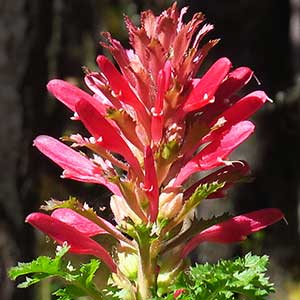Pedicularis densiflora
Pedicularis procera
Indian warrior, warrior's plume
giant lousewort, Gray's lousewort
basal 1–10, blade lanceolate, 30–200 x 20–70 mm, 2(or 3)-pinnatifid, margins of adjacent lobes nonoverlapping or extensively overlapping distally, 1-serrate, surfaces glabrous, hispid, or downy;
cauline 4–20, blade lanceolate, 15–250 x 5–100 mm, 2-pinnatifid, margins of adjacent lobes nonoverlapping or extensively overlapping distally, serrate, surfaces glabrous, hispid, or downy.
basal 2–4, blade lanceolate, 150–250 x 80–120 mm, 2-pinnatifid, margins of adjacent lobes nonoverlapping, entire or serrate, surfaces glabrous or hirsute;
cauline 4–10, blade triangular to lanceolate, 60–300 x 5–90 mm, undivided or 1- or 2-pinnatifid, margins of adjacent lobes nonoverlapping, 2-serrate, surfaces glabrous.
simple, 1–5, exceeding basal leaves, each 10–50-flowered;
bracts lanceolate to trullate, 10–35 x 3–5 mm, undivided or 1-pinnatifid, proximal margins entire, distal 1- or 2-serrate, surfaces glabrous.
simple, sometimes paniculate, 1–3, exceeding basal leaves, each 10–50-flowered;
bracts linear or narrowly lanceolate to subulate, 15–80 x 3–8 mm, undivided, proximal margins entire, distal entire or serrate, surfaces hispid to tomentose.
2–4 mm.
0–1 mm.
calyx 9–18 mm, downy to tomentose, lobes 5, triangular, 3–4 mm, apex entire, ciliate;
corolla 23–43 mm, tube dark red, purple, or orange-yellow, rarely white, 8–18 mm;
galea dark red, purple, or orange-yellow, rarely white, 15–25 mm, beakless, margins entire medially and distally, apex straight;
abaxial lip dark red, purple, or orange-yellow, rarely white, 8–15 mm.
calyx 10–15 mm, hispid to hirsute, lobes 5, triangular, 4–7 mm, apex entire, ciliate;
corolla 22–30 mm, tube light yellow, greenish yellow, or light pink, 10–15 mm;
galea light yellow, greenish yellow, or light pink, with purple to red veins, 9–15 mm, beakless, margins entire medially, 1-toothed distally, apex arching over abaxial lip;
abaxial lip light yellow or light pink, with purple veins, 9–15 mm.
= 16.
= 32.
Pedicularis densiflora
Pedicularis procera
Scarlet corollas with an undomed, toothless galea and two- or three-pinnatifid leaves are diagnostic of Pedicularis densiflora. This species occurs in forested subalpine regions of southern Oregon, western slopes of the Sierra Nevada, and the Coast Ranges of California south to Baja California. Herbarium records indicate northern populations of P. densiflora occur at higher elevations than do more southern populations.
(Discussion copyrighted by Flora of North America; reprinted with permission.)
Although Pedicularis grayi A. Nelson appears in older floras, the name is superfluous and illegitimate. Pedicularis procera Adams ex Steven 1822 is invalid.
Pedicularis procera is the tallest species of Pedicularis in North America. Because the leaves closely resemble those of P. bracteosa, smaller plants can be easily mistaken for this species.
(Discussion copyrighted by Flora of North America; reprinted with permission.)
